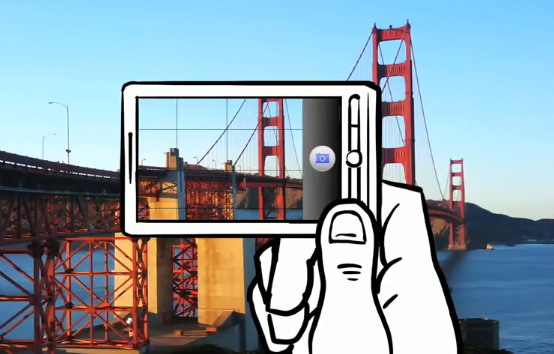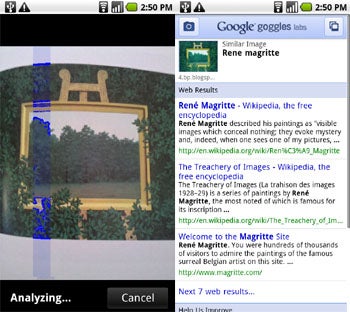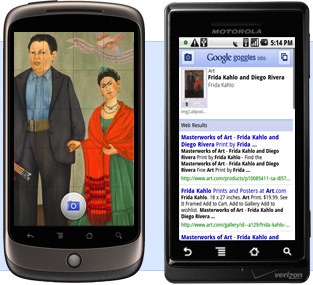Google Goggles Biography
Source(google.com)At first glance, Thad Starner does not look out of place at Google. A pioneering researcher in the field of wearable computing, Starner is a big, charming man with unruly hair. But everyone who meets him does a double take, because mounted over the left lens of his eyeglasses is a small rectangle. It looks like a car’s side-view mirror made for a human face. The device is actually a minuscule computer monitor aimed at Starner’s eye; he sees its display—pictures, e-mails, anything—superimposed on top of the world, Terminator-style.
Starner’s heads-up display is his own system, not a prototype of Project Glass, Google’s recently announced effort to build augmented-reality goggles. In April, Google X, the company’s special-projects lab, posted a video in which an imaginary user meanders around New York City while maps, text messages, and calendar reminders pop up in front of his eye—a digital wonderland overlaid on the analog world. Google says the project is still in its early phases; Google employees have been testing the technology in public, but the company has declined to show prototypes to most journalists, including myself.
Instead, Google let me speak to Starner, a technical lead for the project, who is one of the world’s leading experts on what it’s like to live a cyborg’s life. He has been wearing various kinds of augmented-reality goggles full time since the early 1990s, which once meant he walked around with video displays that obscured much of his face and required seven pounds of batteries. Even in computer science circles, then, Starner has long been an oddity. I went to Google headquarters not only to find out how he gets by in the world but also to challenge him. Project Glass—and the whole idea of machines that directly augment your senses—seemed to me to be a nerd’s fantasy, not a potential mainstream technology.
But as soon as Starner walked into the colorful Google conference room where we met, I began to question my skepticism. I’d come to the meeting laden with gadgets—I’d compiled my questions on an iPad, I was recording audio using a digital smart pen, and in my pocket my phone buzzed with updates. As we chatted, my attention wandered from device to device in the distracted dance of a tech-addled madman.
THINGS REVIEWED:
Google’s ?Project Glass
Starner, meanwhile, was the picture of concentration. His tiny display is connected to a computer he carries in a messenger bag, a machine he controls with a small, one-handed keyboard that he’s always gripping in his left hand. He owns an Android phone, too, but he says he never uses it other than for calls (though it would be possible to route calls through his eyeglass system). The spectacles take the place of his desktop computer, his mobile computer, and his all-knowing digital assistant. For all its utility, though, Starner’s machine is less distracting than any other computer I’ve ever seen. This was a revelation. Here was a guy wearing a computer, but because he could use it without becoming lost in it—as we all do when we consult our many devices—he appeared less in thrall to the digital world than you and I are every day. “One of the key points here,” Starner says, “is that we’re trying to make mobile systems that help the user pay more attention to the real world as opposed to retreating from it.”
By the end of my meeting with Starner, I decided that if Google manages to pull off anything like the machine he uses, wearable computers seem certain to conquer the world. It simply will be better to have a machine that’s hooked onto your body than one that responds to it relatively slowly and clumsily.
I understand that this might not seem plausible now. When Google unveiled Project Glass, many people shared my early take, criticizing the plan as just too geeky for the masses. But while it will take some time to get used to interactive goggles as a mainstream necessity, we have already gotten used to wearable electronics such as headphones, Bluetooth headsets, and health and sleep monitoring devices. And even though you don’t exactly wear your smart phone, it derives its utility from its immediate proximity to your body.
In fact, wearable computers could end up being a fashion statement. They actually fit into a larger history of functional wearable objects—think of glasses, monocles, wristwatches, and whistles. “There’s a lot of things we wear today that are just decorative, just jewelry,” says Travis Bogard, vice president of product management and strategy at Jawbone, which makes a line of fashion-conscious Bluetooth headsets. “When we talk about this new stuff, we think about it as ‘functional jewelry.’” The trick for makers of wearable machines, Bogard explains, is to add utility to jewelry without negatively affecting aesthetics.
Google Goggles Dosti SMS In Hindi urdu Marathi In English Wallpaper Images Marathi Sad Photo

Google Goggles Dosti SMS In Hindi urdu Marathi In English Wallpaper Images Marathi Sad Photo

Google Goggles Dosti SMS In Hindi urdu Marathi In English Wallpaper Images Marathi Sad Photo

Google Goggles Dosti SMS In Hindi urdu Marathi In English Wallpaper Images Marathi Sad Photo

Google Goggles Dosti SMS In Hindi urdu Marathi In English Wallpaper Images Marathi Sad Photo
Google Goggles Dosti SMS In Hindi urdu Marathi In English Wallpaper Images Marathi Sad Photo

Google Goggles Dosti SMS In Hindi urdu Marathi In English Wallpaper Images Marathi Sad Photo

Google Goggles Dosti SMS In Hindi urdu Marathi In English Wallpaper Images Marathi Sad Photo

Google Goggles Dosti SMS In Hindi urdu Marathi In English Wallpaper Images Marathi Sad Photo

Google Goggles Dosti SMS In Hindi urdu Marathi In English Wallpaper Images Marathi Sad Photo

No comments:
Post a Comment